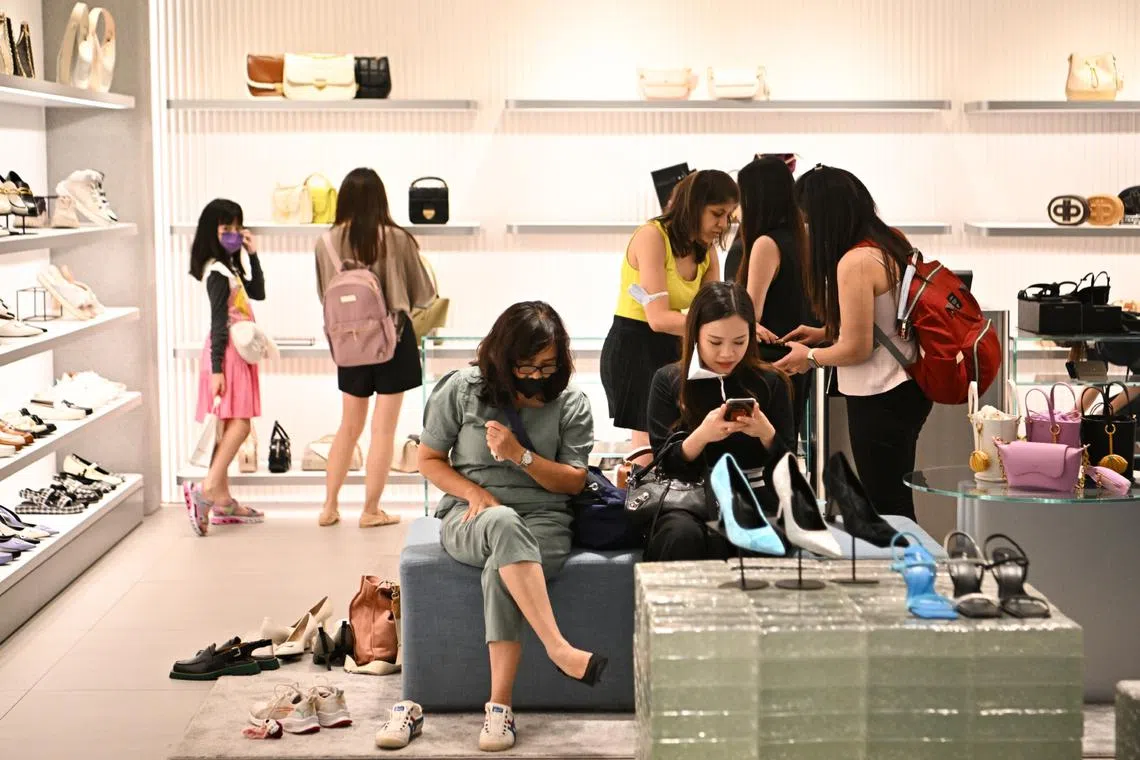Singapore retail sales up 6.2% in November, easing after 7 months of double-digit growth
Sign up now: Get ST's newsletters delivered to your inbox

The estimated total retail sales value in November was $4 billion.
PHOTO: ST FILE
Follow topic:
SINGAPORE - Retail sales in Singapore continued to climb in November, though at a slower pace of 6.2 per cent year on year, according to figures released by the Department of Statistics on Thursday.
November’s takings eased from the double-digit year-on-year growth seen in the last seven consecutive months as tourist spending returned and shoppers front-loaded on big-ticket purchases ahead of Jan 1’s goods and services tax (GST) increase.
October saw retail sales rise 10.4 per cent year on year, while September and August recorded increases of 11.3 per cent and 13.3 per cent, respectively.
Excluding motor vehicles, retail sales in November rose by 8.7 per cent, compared with the 14.3 per cent increase seen in October.
Sales of motor vehicles fell 12.4 per cent in November, which corresponded to the lower certificate of entitlement quota.
OCBC Bank chief economist Selena Ling said November retail sales were below expectations, citing the main drag again to be the sales of motor vehicles. Other retail sales segments that also underperformed were supermarkets and hypermarkets, falling 5.8 per cent year on year; furniture and household equipment, declining 0.7 per cent year on year; and minimarts and convenience stores, decreasing by 0.1 per cent year on year.
“The saving grace is that discretionary spending like apparel, cosmetics, recreational goods, watches and jewellery are all holding up well... However, looking ahead, the darkening economic clouds in terms of growing global recession risks, elevated inflation and complex geopolitical risks, and with gross domestic product growth momentum likely to moderate further, private consumption may soften and retail sales growth is also likely to ease from the 10 per cent year-on-year growth in 2022 to a single-digit growth pace,” she said.
“Still, China’s Covid-19 policy pivot will be interesting to watch if there is a surge in returning Chinese tourists, which may contribute to increased demand for luxury goods in the coming months.”
UOB senior economist Alvin Liew said the bank has conservatively maintained a 2.3 per cent retail sales growth for 2023, with an upside potential mainly from the reopening of China.
Key downside risks are still elevated inflation pressures that may increasingly curb discretionary spending, in addition to the GST hike from 7 per cent to 8 per cent. A favourable low base effect is also likely to fade going into the new year, he added.
“Upside growth factors could still come from the continued recovery in leisure and business air travel and inbound tourism, which will benefit many in-person service sectors, and the impact of China’s reopening from Jan 8, 2023, is likely to be positive for Singapore’s travel- and tourism-related sectors including retail, but the boost from China’s reopening is highly uncertain as there are various factors that may limit the return of inbound Chinese tourists, especially in the near term,” added Mr Liew.
On a seasonally adjusted basis, retail sales dropped 3.7 per cent over October. Excluding motor vehicles, sales fell by 4.3 per cent.
The estimated total retail sales value in November was $4 billion.
Of this, online sales made up an estimated 14.8 per cent, compared with the 13 per cent recorded in October.
The higher online retail sales proportion was mainly attributed to more sales recorded during year-end online shopping events such as Singles’ Day (11.11) and Black Friday.
Within the retail trade sector, most industries recorded year-on-year growth in sales.
The food and alcohol industry saw its takings surge 57.6 per cent, mainly due to higher demand for alcoholic products, including those sold at duty-free shops.
Sales of apparel and footwear rose 34.1 per cent.
Sales of food and beverage (F&B) services grew 24.7 per cent in November year on year, following the 36.9 per cent increase in October.
The large growth in F&B sales was mainly attributed to the low base in November 2021, when there were restrictions on dining at F&B establishments due to the Covid-19 pandemic.


